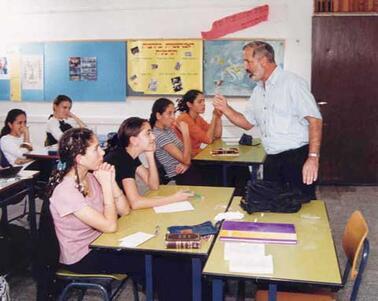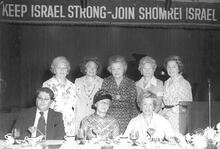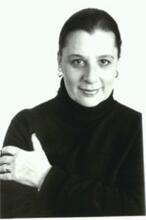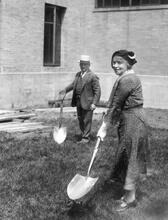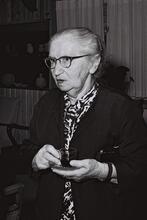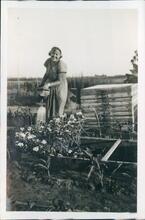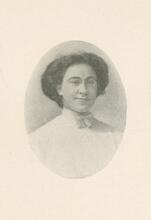AMIT
The Women’s Mizrachi Federation in America, founded in 1925, was led in cities throughout the United States by women who were highly-educated, passionately religious Zionists, active both in their home communities and on behalf of Israel. This Women's Mizrachi event in 1960s Detroit, Michigan, was organized by Yetta Sperka, a playwright, speaker, and activist in women's, Jewish and Zionist causes.
Institution: Deanna Mirsky Sperka, Detroit
Founded in 1925 by Bessie Gotsfeld to create vocational schools for religious girls in Palestine, AMIT is now the largest religious Zionist organization in the United States and has a significant presence in Israel. AMIT in the United States is financially and administratively independent from the National Religious Party in Israel. The organization offers public programming on matters of interest to the Jewish community at large through Days of Learning and symposia on issues confronting Jewish women in the twenty-first century. AMIT has executed many social welfare projects in Israel. Today, AMIT maintains almost 65 schools, youth villages, child-care facilities, and other programs in Israel serving more than 16,000 students from kindergarten through junior college.
Established in 1925 to create vocational schools for religious girls in Palestine, AMIT, an American-based religious Zionist organization, has helped shape the educational and social welfare landscape in the State of Israel for almost a century.
In May 1925, largely through the efforts of founder Bessie Gotsfeld, the Mizrachi Women’s Organization of America (known today as AMIT) was established as a confederation of women’s groups hitherto operating as auxiliaries of the men’s religious Zionist Mizrachi organization.
AMIT in the United States
AMIT is the largest religious Zionist organization in the United States, with more than 40,000 member families in 229 chapters across the country. It has maintained organizational autonomy since 1934, when—in an initiative highly unusual among women in the religious community—it declared its independence from the men’s Mizrachi organization at a Mizrachi convention in Detroit, Michigan. Subsequent changes of name have reflected this autonomy, and the organization dropped the word “Mizrachi” entirely in 1983, when it adopted the name AMIT.
Although adhering to the tenets of religious Zionism, AMIT is a nonpolitical organization, with no administrative or financial ties to the National Religious Party in Israel. It is a constituent organization of the World Zionist Organization and the Conference of Presidents of Major American Jewish Organizations and has Non-Governmental Organization status at the United Nations.
In addition to providing membership services to its chapters, regions, and councils throughout the country, AMIT offers public programming on matters of interest to the Jewish community at large through Days of Learning and symposia on issues confronting Jewish women in the twenty-first century. It also publishes the quarterly AMIT Magazine, which addresses Jewish and Israel-oriented topics.
AMIT in Israel
AMIT’s first project, Beth Zeiroth Mizrachi in Jerusalem, opened its doors in 1933 as the first vocational high school for girls in the country. One of the school’s original staff members, Nehama Leibowitz, who taught there until 1952, subsequently achieved international renown as a Bible scholar and commentator.
A second Beth Zeiroth Mizrachi was established in 1938 on Dov Hos Street in Tel Aviv. In addition to its educational function, the school served, in April 1948, as the site of the historic meeting at which the Actions Committee of the World Zionist Organization adopted a resolution to declare the State of Israel upon the departure of the British mandatory power.
Having established its niche in religious vocational education, AMIT reached a turning point in 1943 with the arrival of several “Teheran children” on the doorstep of its Jerusalem school. These children, part of a group of some eight hundred boys and girls who had escaped from Europe and traveled on foot through the Soviet Union to Persia, had been brought to Palestine by the Youth Lit. "ascent." A "calling up" to the Torah during its reading in the synagogue.Aliyah rescue movement. Most were from religious homes, and there were few available resettlement facilities that could carry on their religious education. AMIT undertook this role as a formal participant in Youth Aliyah and rapidly established a series of child-care facilities to house the flood of youngsters who arrived after World War II and especially following the establishment of the State of Israel. These facilities included several homes for younger children and two youth villages, the Mossad Aliyah Youth Village in Petah Tikvah, established in 1944, and Kfar Batya in Ra’anannah, established in 1947 in honor of Bessie Gotsfeld. The AMIT youth villages have produced numerous well-known figures, among them education minister Zevulun Hammer, a former teacher at Mossad Aliyah, and Kfar Batya alumna Yaffa Eliach, the Holocaust scholar who curated the “Tower of Faces” at the U.S. Holocaust Memorial Museum in Washington, D.C.
Before, during and immediately after World War II, AMIT (then known as Mizrachi Women's Organization of America) was at the forefront of Youth Aliyah, the rescue of Jewish children from Europe and their resettlement in Palestine. Pictured here is the AMIT Youth Village at Petah Tikvah, today the AMIT Kfar Blatt Youth Village and Mishpachton. This group of children were photographed in 1948.
Institution: AMIT Archives
Kfar Batya also witnessed the first arrival in the Jewish state of a group of Ethiopian Jewish students, who took part in a teacher training course (1955–1956) and then returned to their country under an agreement between the Israeli government and Emperor Haile Selassie. AMIT’s exposure to the Ethiopian Jewish culture helped prepare the organization for its subsequent absorption of youngsters arriving with Operations Moses (1984) and Solomon (1991).
Within its dual role, AMIT gradually expanded during the three decades following the establishment of the State of Israel, opening another Beth Zeiroth Mizrachi in Beersheba, several community centers, and three teachers’ seminaries. In the early 1980s, this expansion was dramatically accelerated by two events.
First, in 1981, the organization was designated as the Israeli government’s official network (Reshet) for religious technological education. This moved the existing AMIT schools into the nationwide public religious education system and initiated the incorporation by AMIT of more than twenty additional schools in municipalities throughout the country between 1981 and 1996. AMIT thus became a prominent national voice in religious public education in Israel.
Second, in 1983, two existing AMIT children’s homes were combined in the newly constructed AMIT Beit Hayeled in Gilo, Jerusalem. Beit Hayeled introduced a new concept in Israeli child-care for youngsters from dysfunctional homes: It housed boys and girls age eight to fourteen in nine surrogate-family units. Each unit comprised twelve children, a married couple serving as surrogate parents, and a young woman performing national service. These surrogate families received extensive on-site support services while creating a genuine family environment. Beit Hayeled’s success led to the establishment by AMIT of three satellite surrogate-family homes for younger children and to the transformation in 1994 of the teenage living quarters at the AMIT Youth Village in Petah Tikvah into a surrogate-family residence. Due to the salutary effects of this living arrangement, the village was awarded the Ministry of Education’s Religious Education Prize in 1996 for its achievements with troubled teenagers.
An AMIT HaRoe Elementary School teacher and some of her pupils.
AMIT HaRoe Elementary School is one of three AMIT elementary schools in Sderot, serving hundreds of boys and girls from grades one to six. Some 25 percent of the students at AMIT HaRoe are immigrants from Ethiopia and 30 percent are from the Former Soviet Union.
Photographer: Joe Malcolm.
Institution: AMIT Archives
AMIT Sderot Religious Junior and Senior High School teacher and students.
In 1981, AMIT was designated by the Israeli government as its official reshet (network) for religious secondary technological education. One institution, the AMIT Sderot Religious Junior and Senior High School, enrolls 560 students, offering advanced Judaic studies for boys in a yeshivah program and for girls (pictured above) in an ulpanah (girls' yeshivah).
Photographer: Joe Malcolm.
Institution: AMIT Archives.
AMIT today maintains almost 65 schools, youth villages, child-care facilities and other programs in Israel serving more than 16,000 students from kindergarten through junior college. These include a Pre-Army Religious Studies Program in Rosh Pinnah, which provides post-high school students with high level Torah she-bi-khetav: Lit. "the written Torah." The Bible; the Pentateuch; Tanakh (the Pentateuch, Prophets and Hagiographia)Torah studies combined with the study of Arabic and Middle Eastern culture and history. Like the AMIT “Curriculum on Tolerance and Unity,” which was implemented in all the AMIT high schools following the assassination of Prime Minister Yitzhak Rabin in 1995, the Pre-Army Religious Studies Program fosters amicable relations between observant AMIT alumni and their nonobservant colleagues.
AMIT website (2004).
“Fifty Years,” special section in The American Mizrachi Woman (September–October 1975).
Goldfeld, Leona. Bessie (1981).
Hammer, Zevulun. Letter to AMIT (undated. Received September 4, 1996).
Head, Lee, and Annette Renick. “Fifty Years of Partnership: AMIT Women and Youth Aliyah,” AMIT Woman (March–April 1984): 16+.

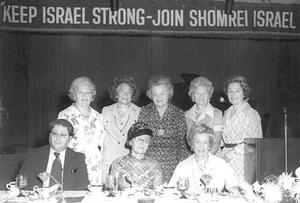
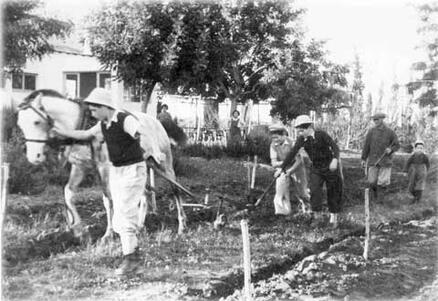
![AMIT-1 - still image [media] AMIT-1 - still image [media]](/sites/default/files/styles/artifacts/public/mediaobjects/AMIT-1.jpg?itok=2Ggui0gP)

